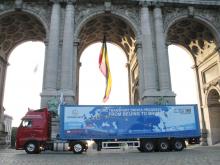
Tony Pearce, honorary life member and former director-general of IRF Geneva, recalls the history of the Silk Roads, highlights their continued economic relevance and introduces IRF's active long-term commitment to their rehabilitation
The Silk Roads had their origins in a Chinese military mission in 138BC to purchase horses in Central Asia's Fergana Valley that were reputed to run so fast that they sweated blood. When General Chang Ch'ien reached Fergana, now in Uzbekistan, he found that the fabled horses bled because of a parasite and were not worth buying, but that local merchants would pay handsome prices for silk.
By the middle of the first century, a trading system was born that built the most-famed oases of Central Asia, from Mashad (Iran) to Bukhara, Samarkand, Tashkent (in Uzbekistan) and Kashgar (in China).
China traded silk, spices, teas and porcelain, while India traded ivory, textiles, precious stones and pepper, and the Roman Empire exported gold, silver, fine glassware, wine, carpets and jewels.
Gunpowder and early modernity in Europe led to the integration of territorial states and increasing mercantilism. Meanwhile on the Silk Road, gunpowder and early modernity had the opposite impact: the level of integration of the Mongol Empire could not be maintained, and trade declined. From around 1400, the land routes were supplemented by sea routes which extended from the Red Sea to East Africa, India, China and Southeast Asia.
In the 14th century, it would take a caravan up to a year to make the 6,000km trip. Over time all manner of goods were carried along these roads, from the most expensive cloth to the most mundane ox hide. But few, if any, individuals made the entire trip. Instead, goods were passed along through a network of middlemen who rarely travelled outside their own regions.
Even today, most of the traffic along the Silk Roads travels relatively short distances.
Nevertheless, in 2005 the
Almost half of the world's cargo traffic is made up of goods transported between Europe and Asia. Trade volume between the two sides was US$480 billion in 2010. But only 1% of the cargo transported between the EU and the Asia Pacific region uses the international land transport corridors. Most of the international road traffic is carried on a core network of around 20,000km of mainly two-lane roads.
Reopening the Silk Roads to trade also drives economic and social development, political stability and progress and prosperity in all countries along the routes.
During the Soviet period, the main transport focus was moving goods and people to and from the Russian capital Moscow, and the routes across Central Asia were neglected.
A preliminary study carried out by the
In 2007, the attention moved to the western end of the network with a meeting held in Istanbul.
The present challenges for the Silk Road network include barriers at borders; lack of coordination of national policies; lack of logistics, infrastructure and services, and the poor quality of the road infrastructure. Delays for imports and exports of goods have a major negative impact on trade. Long hold-ups make it impossible to export perishable agricultural products such as meat, fruit and vegetables, particularly important for the economies of Central Asia.
What is needed is the simplification and harmonisation of visa regimes and border crossing rules and procedures; creation of an attractive and predictable investment environment; deregulation of international tariffs, and improving professionalism at customs and border services. Big strides are being made on this through ECO, with its Transit Trade Facilitation Agreement, and through the EU's support for the TRACECA programme.
Delays are also created by the internal barriers to trade within countries, such as numerous roadblocks and attempts by local governments to restrict access to local markets and bazaars. These are driving up price differences across the region to levels that are at least as high as differences between countries. These barriers to trade are significant and damaging.
The fact that there are very few functioning modern logistics centres in the region means that most transport is mono-modal or, if goods are transferred between modes, it is costly and time consuming. This is one reason why transport costs in the region are some of the highest in the world with many goods moved long distances by road. Modern multi-modal trans-shipment facilities allowing long distance movement of many goods by rail, with road transport for local delivery, are not available.
Modern logistics centres can make this modal transfer quick and effective, though there are other benefits, such as centralising the functions of vehicle overloading control, as well as issuing operating permits to foreign vehicles.
In addition, logistics centres located near to special economic industrial zones increase the attractiveness to investors by providing low- cost and efficient transport facilities.
Much of the major road network is in poor condition because of lack of finance for maintenance. In some countries, as little as 0.05% of gross domestic product (GDP) is spent on road maintenance (the World Bank suggests a figure of 1.5% of GDP).
One of the sections of the Silk Roads carrying the heaviest traffic is from Tashkent to Samarkand in Uzbekistan, with 25,000 vehicles/day. The road is a four-lane dual carriageway, but the surface is bad with dangerous driving conditions. The Uzbek government has plans to upgrade many of its major roads particularly along the E40 from Bukhara to Samarkand, Tashkent and through the Fergana Valley to Kyrgyzstan and on into China.
A study in 2008 estimated that approximately $6.5 billion is required to upgrade roads and improve surface condition of the Silk Roads. The benefits would be substantial: with a 50% increase in road quality indices intra-regional trade would increase by 20% to $48.7 billion annually and a 75% improvement in road quality would produce an intra-regional trade increase of 35% to $89.5 billion/year.
The first priority is for road condition improvements and then, where necessary, upgrading to a higher class of road. These results are consistent with the transportation economics viewpoint that road upgrades decrease transportation costs (such as fuel consumption) and user-cost (travel time).
Higher traffic volumes allow the policymakers to take advantage of the higher trade volumes and decrease tariff rates, encouraging more transit.
The problems call for the adoption of urgent and effective measures, otherwise mounting deficiencies in infrastructure will become an increasing barrier to economic growth. One solution could be a programme of urgent, well-coordinated actions for the creation of conditions for the use of Public- Private Partnerships (PPPs). In most of the countries of the region, this would require reforms of the regulatory framework, adaptation of PPP approaches and mechanisms, and a gradual expansion of PPP use based on progress with the appropriate reforms and experience gained.
The process of gaining the necessary experience and demonstrating feasibility of the PPP model is needed before it can be expanded on a larger scale. The rebuilding of the Silk Roads has begun, but much more needs to be done. There is a clear role for the private sector, and a willingness of governments in the region to work with international organisations to make this happen.









